

(No. 90, March 1999, pages 10-12)
Fakes controversies
Cézanne joins Van Gogh for close scrutiny
The current exhibition at the Grand Palais gives the Musée d'Orsay's verdict on its own questioned Van Goghs and draws attention to problems with other Van Goghs and Cézannes from the Gachet Collection.
Amid mounting concern, the Musée d'Orsay courageously decided to tackle the problem. "Organising an exhibition with works which have seldom been shown in recent years, and therefore little studied, seemed the best way to help the public understand the terms of the controversy," said curator Anne Distel.
"Un ami de Cézanne et de Van Gogh: le docteur Gachet", co-curated with Susan Stein from the Metropolitan, is at the Grand Palais until 26 April. The exhibition then travels to New York's Metropolitan Museum (25 May-15 August) and the Van Gogh Museum in Amsterdam (24 September-5 December).
Although originally planned just for Paris, the New York and Amsterdam museums were keen to participate because so few paintings from the Gachet donation have ever been shown outside France. On loan will be eight Cézannes and eight Van Gogh's (including the magnificent self-portrait once owned by Dr Gachet), plus works by Monet, Pissarro, Renoir and Sisley.
Also included in the exhibition are memorabilia preserved by Dr Gachet: the palettes of Cézanne and Van Gogh, vases which the two masters depicted in their still lifes, Japanese prints found in Van Gogh's garret room in the Auberge Ravoux, and even the cap which Dr Gachet wore in the pair of portraits by Van Gogh. Particularly poignant are five rarely exhibited pictures by Dr Gachet of Van Gogh on this deathbed. Another exhibit is a landscape painting done in 1904 by Dr Gachet's son, Paul Gachet fils, captioned "De l'endroit où Vincent s'est suicidé". This work could resolve the puzzle of the location where Van Gogh actually shot himself: it does not depict the legendary wheatfield, but a small farm track behind the Château d'Auvers. Also on show is a recently discovered letter from Dr Gachet to Theo van Gogh, dated 27 July 1890: "Today, Sunday, at nine o'clock in the evening I was sent for by your brother Vincent, who wanted to see me at once. I went there and found him very ill. He has wounded himself . . . it is your duty to come." But although the exhibition provides
an insight into Dr Gachet and his avant-garde friends, more visitors seem far more interested in what the show says about the fakes scandal.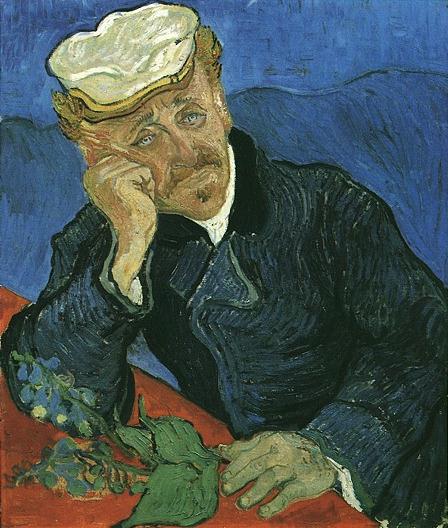
Master faker?
It was the mysterious appearance of the Gachet collection nearly fifty years ago which led to the first accusation of fakery. The two children of the doctor, Paul Gachet fils and his sister Marguerite, were reclusive, and they became increasingly reluctant to show art historians the treasures which had been collected by their father. They refused to
allow the paintings to the photographed and rarely lent to exhibitions. Until a series of donations to French museums in 1949-54, many of their greatest masterpieces remained virtually unknown. When the Gachet donations were assembled in 1954 for a spectacular exhibition at the Musée de l'Orangerie critic Louis Anfray immediately raised questions of authenticity. He pointed out that both Dr Gachet and his son were both amateur artists, so they could have made fakes and included them among the authentic works. These claims were also fuelled by the sheer number of paintings which had apparently survived from Van Gogh's seventy days in Auvers: around eighty pictures, a production of more than one a day.
Doubts about the Gachet pictures were recently re-ignited when scholar Jan Hulsker published the revised edition of his The New Complete Van Gogh, which questioned three pictures ("Asylum garden at St Paul's Hospital", "Portrait of Dr
Gachet" and "The cows"). Detailed evidence was presented by independent research Benoît Landais in the magazine Connaissance des Arts in September 1997.
Although the recent fakes controversy has focused on Van Gogh, the authenticity of many of Dr Gachet's Cézannes is also questioned in the recent catalogue raisonné. Based on the work of the late John Rewald, The Paintings of Paul Cézanne was completed by Walter Feilchenfeldt and Jayne Warman. In his introductory essay, Zurich scholar and dealer Feilchenfeldt explained that a number of works from the Gachet collection although included in the catalogue are "in need of further investigation".
Revelations at the Grand Palais
For the exhibition, Dr Gachet's Van Goghs and Cézannes in French museums were all subjected to a detailed technical examination by the Laboratoire de recherche des musées de France, based in the Louvre. In the case of the Van Goghs, it was found that the artist had used similar rough canvas for all his Auvers pictures (except for "Church at Auvers", an unquestioned masterpiece). X-rays reveal that Van Gogh painted with "a rapidity of execution and a lack of hesitation". The investigation concluded that all the Van Goghs donated by Dr Gachet are authentic.
One point of particular interest which emerged was that some of Van Gogh's cheap pigments have faded. For instance, the purple foxglove flowers in the Musée d'Orsay's "Portrait of Dr Gachet" were originally painted with red lake and ultramarine, but the red has faded , leaving the flowers unnaturally bluish. This colour change is confirmed by the existence of an excellently preserved watercolour copy of the portrait done by Dr Gachet's friend Blanche Derousse in 1901, which depicts purple flowers. Although the other version of the "Portrait of Dr Gachet" sold to Japan in 1990 was not examined, photographs show that it too appears to have suffered a similar colour change—further evidence of the authenticity of the Orsay picture.
The Cézannes in the Gachet donation were also studied, and again the evidence suggests that they are authentic. One particular example was particularly telling. Dr Gachet made an oil copy of one of the Cézannes, "A modern Olympia", and this offered an opportunity to make a direct comparison of the techniques of the two artists. While Cézanne worked quickly and confidently, Dr Gachet's copy is laboured.
After examining other works and copies by Dr Gachet (who painted under the pseudonym Paul Van Ryssel) and his son (who painted as Louis Van Ryssel) it was concluded that neither was a sufficiently competent artist to convincingly fake the work of Van Gogh or Cézanne. When the Gachets made copies, they first drew the outlines and then filled in the colours, almost like a child painting by numbers. The same could be said of copies made by two friends of the family, Blanche Derousse and Théophile Elémore Bigny, who made small watercolour copies as records of the originals. Anne Distel concludes that she has "no doubts about the authenticity" of the Van Goghs and Cézannes donated to the French museum.
Remaining questions about Cézanne and Van Gogh
But even if one accepts the paintings donated to the French museums as authentic, doubts have been raised about certain works which were quietly sold off by Gachet fils. At the back of the Grand Palais catalogue—and so far virtually ignored by the critics—there is considerable information about other Van Goghs and Cézannes which scholars have questioned.
Written by Susan Stein, this section is based on one of the major discoveries made by the exhibition organisers: a five-volume typescript catalogue of the collection, compiled by Gachet fils in 1928. Previously unknown to scholars, this key document is now owned by the Wildenstein Institute in Paris. This shows, for instance, that the Art Institute of Chicago's "Panoramic View of Auvers" (R221) originally belonged to Dr Gachet. Working from the Gachet fils typescript, Ms Stein has provided in-depth scholarly references for the entire collection. Although open about citing cases where authenticity has been questioned, the dispersed pictures do not form part of the Grand Palais exhibition and she does not wish to make judgements on them. "What we have tried to do is provide solid factual information as the basis for
further serious study," Stein explained.
The Gachet fils catalogue records twenty-six paintings by Van Gogh (plus eighteen drawings), twenty-six by Cézanne (plus seventeen watercolours and drawings), twelve by Pissarro (including a lost 1872 picture of St Stephen's Church in Norwood, South London), as well as Monets, Renoirs, etc.
This catalogue confirms that although Gachet fils donated fifteen of the finest Van Goghs and Cézannes to French museums, he sold off a much larger number. Indeed Gachet fils and his sister apparently never earned a living, but raised money by selling works collected by their father.
Out of Dr Gachet's twenty-six Van Goghs, the authenticity of six has been questioned. Of the six, three are in the show and have now been authenticated. This leaves three others: one in the Van Gogh Museum which is expected to be examined shortly and two elsewhere (in a private collection and in the Nationalmuseum, Stockholm).
Out of Dr Gachet's twenty-six Cézannes, eleven are questioned by Feilchenfeldt (to varying degrees) in the recent Rewald catalogue. Other experts such as Professor Theodore Reff of Columbia University, do not accept all of Feilchenfeldt's doubts. Two of the questioned works are in French museums; one was downgraded some years ago and the other has now been authenticated. There are nine elsewhere, all in private collections, except for one in the Fogg Art Museum.
Our analysis therefore reveals that no fewer than seventeen of Gachet's fifty-four Van Goghs and Cézannes have been questioned. Most of the questioned works which were sold by Gachets fils have subsequently passed through the international auction houses.
Gachet fils donated fifteen Van Goghs and Cézannes to French museums (including "Church at Auvers", sold for half its market value), but he sold the remaining thirty-eight, mostly to Wildeenstein. Cynics might argue that had Gachet fils wished to sell fakes, he would have presented the finest paintings to French museums and mixed fakes among the lesser works which he sold. Others would say that this is an unfair judgement, and with such a large collection, Gachets fils had relatively little to gain from selling some extra fakes in his old age. Ms Stein accepts that a few of the Van Goghs and Cézannes outside French museums may turn out not to be authentic, but if so, Gachet fils had confused works by his father's other artist friends, "I do not believe there was deliberate deceit, but because the knowledge of Gachet fils about his father's collection was limited, there is always the possibility of misattribution," Stein commented.
The debate looks set to continue when the Gachet show opens in New York. Metropolitan director Philippe de Montebello promises that the exhibition will confront the issues: "it will engage the public in a thought-provoking dialogue about masterpiece and copy, and the other vexing issues of authenticity."
Martin Bailey
It was
Pissarro who later suggested that Van Gogh should come to Auvers, pointing out that Dr
Gachet, then sixty-one, could keep a friendly eye on his health. And so, on 20 May 1890,
after leaving the asylum at St-Rémy, Van Gogh moved into the Auberge Ravoux. Van Gogh
immediately became a regular visitor to the house, where the widowed doctor lived with his
sixteen-year-old son Paul and twenty-year-old daughter Marguerite. Often eating with the
family, Van Gogh also painted in their house and garden. Tragedy came only too quickly,
and after Van Gogh shot himself on 27 July 1890 it was Dr Gachet who treated this wound
during the final days of his life.
After Dr Gachet's death in 1909, his art collection then passed to his two
children. Paul (and his wife) and Marguerite continued to live in their father's
house, but they became increasingly reclusive as the years went by. Eventually, the
Gachets made a spectacular series of donations to French museums, primarily the Louvre. In
1949 Paul and Marguerite offered two Van Gogh masterpieces: the powerful self-portrait
with the swirling background done in St-Rémy and the second version of the portrait of Dr
Gachet, as well as self-portrait by Guillaumin. Marguerite later died that year.
In 1951 Paul Gachet fils made a further gift to the Louvre. This
included three paintings by Cézanne, two each by Pissarro and Guillaumin, and one each by
Monet, Renoir, Sisley and the Puerto Rican artist Francisco Oller. Another Van Gogh
masterpiece, "The church at Auvers", was sold to the Louvre for 8 million old
francs, half its market value, Paul Gachet fils also donated Van Gogh's oil
version of "The cows" by Jacob Jordaens to Lille's Palais des Beaux-Arts,
which owns the original Jordaens.
In 1954 Paul Gachet fils made his final major donation in French
museums: four paintings by Cézanne, three by Guillaumin, a Pissarro, an oil sketch
attributed to Constantin Guys, and five more Van Goghs: "Marguerite Gachet in the
garden", "In the garden of Dr Gachet", "Cottages at Cordeville",
"Two girls" and "Roses and anemones". Paul Gachet fils died in
1962, making him one of the last people to have known Van Gogh.
Dr Paul Gachet (1828-1909) was the most
extraordinary of the early patrons of the Post-Impressionists. Born in Lille in 1828, he
studied medicine and specialised in the problems of melancholia. In 1858 he moved to Paris
to practise as a doctor, and soon developed a reputation for offering alternative
remedies. Although continuing to work in the capital, in 1872 he bought a house in
Auvers-sur-Oise, twenty-five kilometres to the north. The rolling landscape around the
village had proved an attraction to painters, and Dr Gachet soon got to know Daubigny,
Guillaumin, Pissarro, all of who painted there. Most importantly, he became friends with
Cézanne, who stayed in Auvers in 1872-74. Dr Gachet began to collect the work of the
avant-garde and he was inspired to become an amateur artist.
Questioned Van Goghs and Cézannes from the Gachet Collection*
In the Grand Palais exhibition
Cézanne, "Still life with a medallion of Solari"
(R211), Musée d'Orsay. Cézanne, "Still-life, pears and green apples"
(R-), Musée de l'Orangerie.
Cézanne, "Landscape: Guillaumin sitting under a
tree" (R59), Michael Werner, Cologne. Cézanne, "Dead birds" (R206), Fogg Art Museum,
Cambridge, Mass. Cézanne, "Still-life with an Urbino pot" (R204),
private collection. Cézanne, "Italian faïence" (R205), private
collection, Japan. Cézanne, "Apples and a glass" (R20), private
collection, Japan. Cézanne, "Hamlet and Horatio, after Delacroix"
(R232), private collection. Cézanne, "Three brothers" (R358), Elliott Wolk,
Scarsdale, NY.
* H and R numbers refer to the catalogues of Jan Hulsker (The New Compete Van Gogh, 1996, J.M. Meulenhoff/John Benjamins) and John Rewald (The Paintings of Paul Cézanne, 1996, Abrams). The verdict "undetermined" means that Musée d'Orsay curators have not considered the authenticity of the work, since it does not form part of their exhibition.
Van Gogh fakes: an update on other developments
Donated by Gachet fils and Marguerite Gachet to the Louvre, 1949.
THE DOUBTS: Hulsker argues that this is based on the original portrait,
which in 1990 was sold for a record of $82 million to Japanese businessman Ryoei Saito.
"The problem is that Van Gogh's letters do not contain a simple indication that
he ever made a second version," Hulsker explains, adding that it had only been
accepted because of the evidence of Gachet fils, who was "totally
unreliable". The 1970 catalogue raisonné quotes Baart de la Faille's
description of the picture as "a very weak replica". The portrait has also been
rejected by Anfray (1954), H.R. Graetz (1963), David Outhwaite (1969) and Landais (1999).
VERDICT: AUTHENTIC. Although the curators admit the picture has been
"much debated", they give various possible explanations as to why Van Gogh did
not mention the second version in his letters. Most important, they give the results of
their technical analysis which suggests it is authentic. The curators "regret"
that it proved impossible to borrow the other version of the portrait, so they could be
compared (they have never been exhibited together). The Art Newspaper has confirmed
rumours that the painting was sold recently, following the death of Ryoei Saito in 1996.
The new owner is non-Japanese and the sale was negotiated through a London-based auction
house.
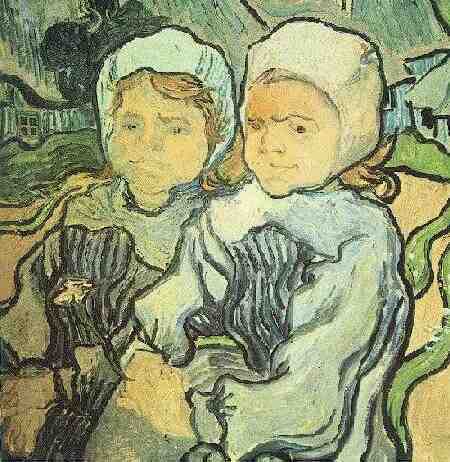 Van Gogh, "Two children" (H2051), Musée
d'Orsay.
Van Gogh, "Two children" (H2051), Musée
d'Orsay.
Donated by Gachet fils to the Louvre, 1954.
THE DOUBTS: Rejected by Outhwaite and attributed to Derousse (1969). Also
questioned by Landais.
VERDICT: AUTHENTIC. Another version of this picture (in a private
collection) was examined several years ago and the Orsay picture shares important
characteristics. The curators conclude: "It is hoped that the technical similarities
of the two versions will end the debate."
 Van Gogh, "The cows" (H2095), Palais des Beaux-Arts, Lille.
Van Gogh, "The cows" (H2095), Palais des Beaux-Arts, Lille.
Donated by Gachet fils to Lille, 1950.
THE DOUBTS: The painting, based on a print by Dr Gachet of "The
cows" by Jacob Jordaens, has long been controversial. It was rejected by Baart de la
Faille, but accepted as authentic by the editors of the 1970 version of the catalogue
raisonné. In 1996 Hulsker commented that "we only have Paul Gachet's testimony
of 1954 that it was done by Vincent". The picture is also rejected by Roskill and
Landais.
VERDICT: AUTHENTIC. The curators state that the laboratory examination
has revealed no anomaly." They conclude it is "an original, unsuccessful
sketch."
Donated by Gachet fils to the Louvre, 1954.
THE DOUBTS: Rewald is dismissive of its quality: "One would be
tempted to deny that Cézanne could have painted so insignificant a work if it were not
for the formal testimony of Dr Gachet's son and if other still-lifes, executed in
Auvers-sur-Oise, did not fail from similar faults." Feilchenfeldt says that it
"should be given further critical examination", since it is not recorded in the
Vollard archive (The Vollard photograph has now been found and is reproduced in the
exhibition catalogue).
VERDICT: AUTHENTIC. The curators point out that it does not seem
plausible to take such an "unattractive" picture, although it might be a
misattribution (but none of the obvious candidates seem convincing). They conclude that it
should be still attributed to Cézanne, who was "unfortunately capable of mediocre
work."
Sold by Gachet fils and later acquired by Jean Walter-Paul Guillaume in 1951
(purchased by the national museums in 1963).
THE DOUBTS: The picture was acquired by Guillaume as a Cézanne (it is
inscribed on the reverse, apparently by Dr Gachet "Auves/September
1873/Paul-Cézanne). Rewald rejected the picture, pointing out that it is somewhat similar
to a Cézanne from the Gachet collection now in a private collection (R209, ex M. and Mme
Huisman, Paris). The Orangerie picture was downgraded by the museum in 1984 and is
currently on display at the Grand Palais as "formerly attributed to Cézanne".
Distel describes it as "a modest work, not without virtue."
VERDICT: FAKE.
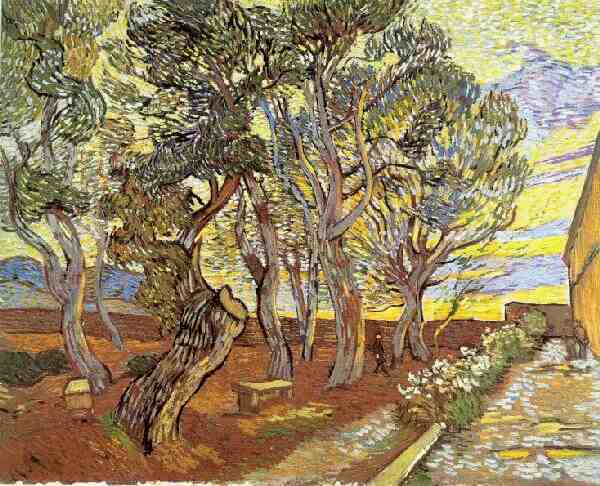 Van Gogh, "Asylum garden at St
Paul's Hospital" (H1850), Van Gogh Museum.
Van Gogh, "Asylum garden at St
Paul's Hospital" (H1850), Van Gogh Museum.
Given by Gachet fils to Vincent Willem van Gogh, 1954.
THE DOUBTS: Vincent Willem van Gogh, nephew of the artist, denounced the
picture as a fake in 1954, just after being presented with it as a gift. Hulsker also
questions it, emphasising that Vincent Willem van Gogh "did not consider it to be an
authentic work". Hulsker argues that it is a copy of a genuine painting in Essen.
Professor Mark Roskill, a leading American academic specialist on Post-Impressionism, told
The Art Newspaper that he too rejects the picture.
VERDICT: PROBABLY AUTHENTIC, BUT STILL TO BE EXAMINED. Although rejected
by Vincent Willem van Gogh and Hulsker, the curators point out that "numerous other
specialists . . . accept it as a second version", including Ronald Pickvance, Roland
Dorn and Evert van Uitert. The picture was not lent to the Grand Palais, for conservation
reasons. Van Gogh Museum director John Leighton told The Art Newspaper that there are
"no obvious reasons to doubt its authenticity". He added: "However, given
that it is the only significant picture in our collection which has been doubted and given
also that these doubts stem from the founder of our museum. I would be very keen to settle
this issue once and for all by carrying out an extensive study on the painting."
Leighton hopes this will be done before the exhibition opens in Amsterdam in September.
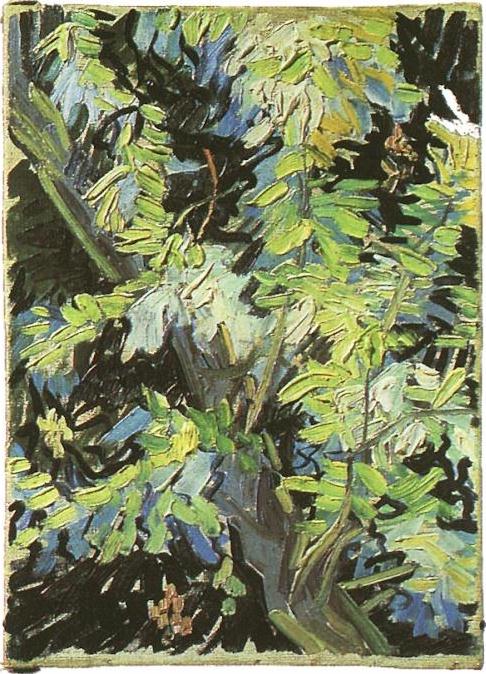 Van Gogh, "Branches of
flowering acacia" (H2015), Nationalmuseum, Stockholm.
Van Gogh, "Branches of
flowering acacia" (H2015), Nationalmuseum, Stockholm.
Sold by Gachet fils in 1941 (purchased by the museum in 1966).
THE DOUBTS: Rejected by Baart de la Faille, but accepted as authentic by
the editors of the 1970 version of his catalogue raisonné.
Landais rejects the picture as "pure Gachet fils".
VERDICT: UNDETERMINED. Accepted as authentic by the Nationalmuseum.
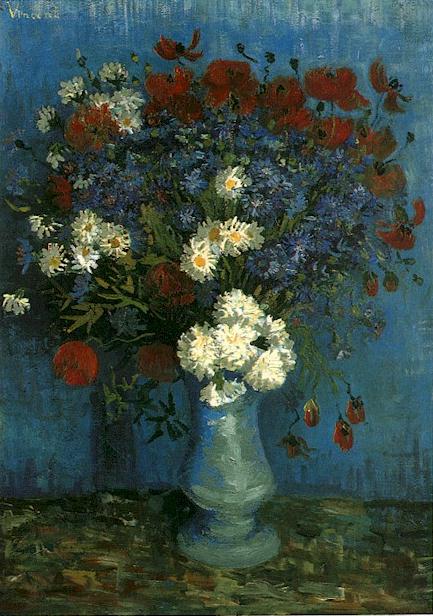 Van Gogh, "Vase with
cornflowers and poppies" (H1293), private collection.
Van Gogh, "Vase with
cornflowers and poppies" (H1293), private collection.
Sold by Gachet fils before 1912.
THE DOUBTS. The still life is "not accepted" by Toronto-based
Professor Bogomila Welsh-Ovcharov, the leading specialist on Van Gogh's Paris period.
VERDICT: UNDETERMINED.
Sold by Gachet fils to Wildenstein, 1956.
THE DOUBTS: Rewald commented that since the painting dates from about
1865, it is "puzzling" that it belonged to Dr Gachet, who settled in Auvers in
1872. Feilchenfeldt argues that it "should be given further critical
examination", since it is not recorded in the Vollard archive. Professor Theodore
Reff of Columbia University also rejects it: "The whole work seems so ‘vaguely
brushed' and spurious execution, so blatant in its colouring and obvious grid-like
design, that it is hard to accept."
VERDICT: UNDETERMINED.
Sold by Gachet fils to Wildenstein, 1951 (donated to the museum in 1976).
THE DOUBTS. The painting was challenged by Cooper (1975). A 1984
catalogue of the David and Peggy Rockefeller collection records that Rewald has "not
made a final decision" as to whether he will include this work in his forthcoming
catalogue raisonné. David Rockefeller admitted that he had given the picture to the Fogg
Art Museum as a picture to use for "study" purposes. Feilchenfeldt comments:
"By including this painting Rewald followed the principle to accept rather than to
reject in questions of doubt."
VERDICT: UNDETERMINED. Accepted as authentic by the Fogg.
Sold by Gachet fils to Wildenstein, 1953.
THE DOUBTS: Feilchenfeldt says this work has been questioned by other
experts. He argues it "should be given further critical examination", since it
is not recorded in the Vollard archive.
VERDICT: UNDETERMINED.
Sold by Gachet fils to Wildenstein, 1951.
THE DOUBTS: Feilchenfeldt comments that "anybody who does not share
Rewald's high opinion of Paul Gachet fils' integrity will be less willing to
accept this painting's attribution to Cézanne." Feilchenfeldt adds that the
dealer Paul Rosenberg, the best connoisseur of Cézanne of this generation, did not accept
its authenticity. "For the same reason this painting was withdrawn from a
Sotheby's sale in 1961 (6 December)."
VERDICT: UNDETERMINED.
Sold by Gachet fils to Alfred Daber Gallery, Paris, before 1953.
THE DOUBTS: Feilchenfeldt argues it "should be given further
critical examination", since it is not recorded in the Vollard archive.
VERDICT: UNDETERMINED.
Sold by Gachet fils between 1936 and 1953.
THE DOUBTS: Feilchenfeldt argues "it should be given further
critical examination", since it is not recorded in the Vollard archive."
VERDICT: UNDETERMINED.
Sold by Gachet fils to Wildenstein, 1960.
THE DOUBTS: Feilchenfeldt suspects the picture is a copy of a Cézanne
drawing. Although included in the Rewald catalogue, Rewald wrote
"authenticity??" in the margin of his personal copy of the earlier Venturi
catalogue.
![]() An exhibition in Rotterdam included Van Gogh fakes, which duly labeled as forgeries. "Flower still lifes from the Netherlands and Belgium 1870-1940", closed at the Kunsthal on 28
February, and had three authentic Van Goghs, along with three fakes from the vaults of the Kröller-Müller Museum ("Still life with flowers" H1103, "Jug with carnations" H1126; and "Vase with carnations" H1133). A seventh painting, "Vase with gladioli" H1131, (Boimans Van Beuningen Museum) is questioned by some specialists, but accepted by the Rotterdam museum.
An exhibition in Rotterdam included Van Gogh fakes, which duly labeled as forgeries. "Flower still lifes from the Netherlands and Belgium 1870-1940", closed at the Kunsthal on 28
February, and had three authentic Van Goghs, along with three fakes from the vaults of the Kröller-Müller Museum ("Still life with flowers" H1103, "Jug with carnations" H1126; and "Vase with carnations" H1133). A seventh painting, "Vase with gladioli" H1131, (Boimans Van Beuningen Museum) is questioned by some specialists, but accepted by the Rotterdam museum. ![]() The exhibition "Drawings by Van Gogh and his contemporaries", which closed at the Kröller-Müller Museum on 2 January, included a warning: "The authenticity of some works is questionable. In particular, opinion differs as to who made the four early drawings in the first room." These four childhood drawings (depicting a bridge, a milk jug, a dog and a Corinthian capital) have traditionally been said to date from 1862-63, when Van Gogh was aged between eight and ten.
The exhibition "Drawings by Van Gogh and his contemporaries", which closed at the Kröller-Müller Museum on 2 January, included a warning: "The authenticity of some works is questionable. In particular, opinion differs as to who made the four early drawings in the first room." These four childhood drawings (depicting a bridge, a milk jug, a dog and a Corinthian capital) have traditionally been said to date from 1862-63, when Van Gogh was aged between eight and ten.![]() Controversy still surrounds "Garden at Auvers" H2107. The owners, Pierre and Edith Vernes, are seeking to have the 1992 sale cancelled, on the grounds that there are sufficient doubts about the work's authenticity.
Controversy still surrounds "Garden at Auvers" H2107. The owners, Pierre and Edith Vernes, are seeking to have the 1992 sale cancelled, on the grounds that there are sufficient doubts about the work's authenticity. ![]() It is hoped that the Yasuda "Sunflowers" H1666 will be examined at the Van Gogh Museum in 2002, in connection with an exhibition of Van Gogh and Gauguin.
It is hoped that the Yasuda "Sunflowers" H1666 will be examined at the Van Gogh Museum in 2002, in connection with an exhibition of Van Gogh and Gauguin.
Umberto Allemandi and Co
27-29 Vauxhall Grove
London
SW8 1SY
Reprinted with permission
 Return to Van Gogh fakes page
Return to Van Gogh fakes page